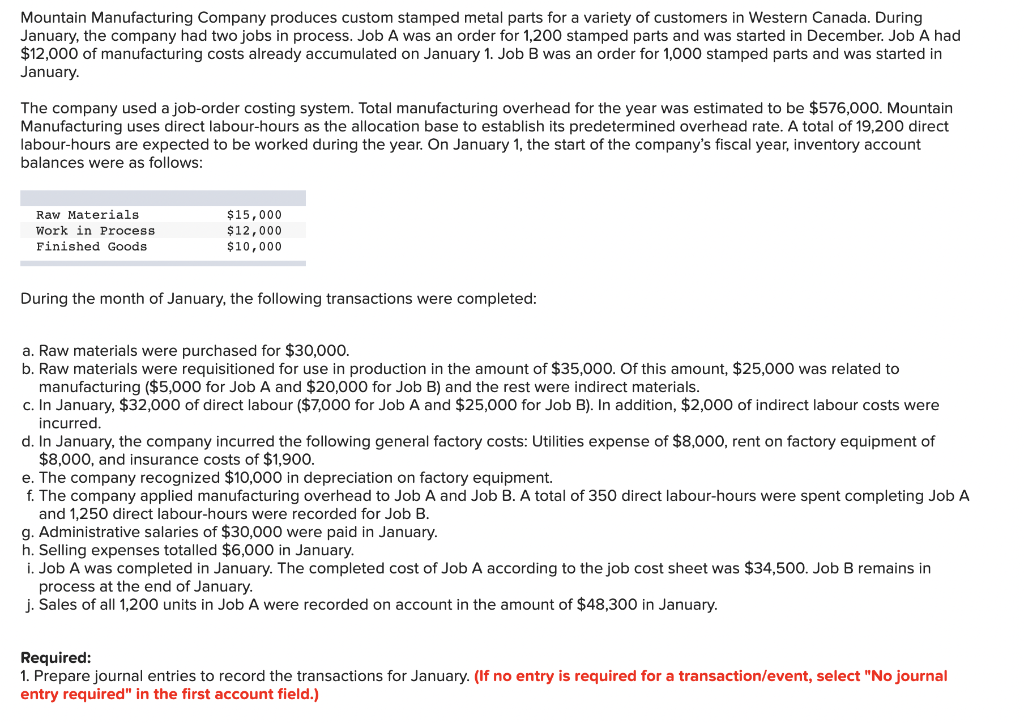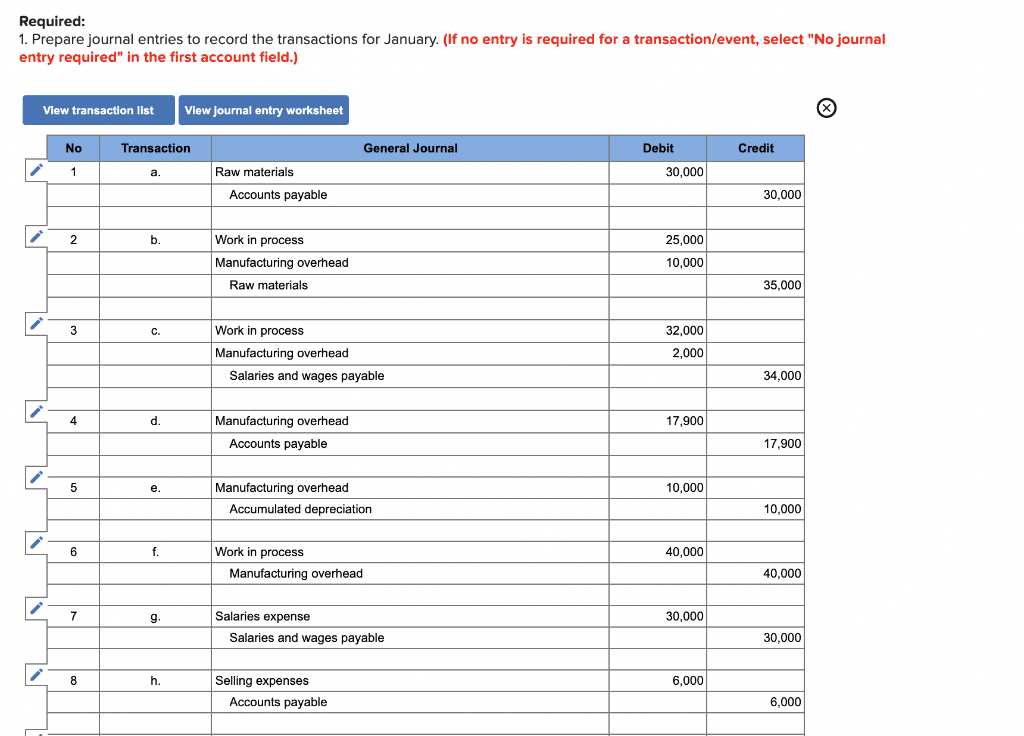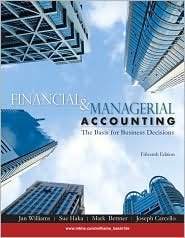



Mountain Manufacturing Company produces custom stamped metal parts for a variety of customers in Western Canada. During January, the company had two jobs in process. Job A was an order for 1,200 stamped parts and was started in December. Job Ahad $12,000 of manufacturing costs already accumulated on January 1. Job B was an order for 1,000 stamped parts and was started in January. The company used a job-order costing system. Total manufacturing overhead for the year was estimated to be $576,000. Mountain Manufacturing uses direct labour-hours as the allocation base to establish its predetermined overhead rate. A total of 19,200 direct labour-hours are expected to be worked during the year. On January 1, the start of the company's fiscal year, inventory account balances were as follows: Raw Materials Work in Process Finished Goods $15,000 $12,000 $10,000 During the month of January, the following transactions were completed: a. Raw materials were purchased for $30,000. b. Raw materials were requisitioned for use in production in the amount of $35,000. Of this amount, $25,000 was related to manufacturing ($5,000 for Job A and $20,000 for Job B) and the rest were indirect materials. c. In January, $32,000 of direct labour ($7,000 for Job A and $25,000 for Job B). In addition, $2,000 of indirect labour costs were incurred. d. In January, the company incurred the following general factory costs: Utilities expense of $8,000, rent on factory equipment of $8,000, and insurance costs of $1,900. e. The company recognized $10,000 in depreciation on factory equipment. f. The company applied manufacturing overhead to Job A and Job B. A total of 350 direct labour-hours were spent completing Job A and 1,250 direct labour-hours were recorded for Job B. g. Administrative salaries of $30,000 were paid in January. h. Selling expenses totalled $6,000 in January. i. Job A was completed in January. The completed cost of Job A according to the job cost sheet was $34,500. Job B remains in process at the end of January. j. Sales of all 1,200 units in Job A were recorded on account in the amount of $48,300 in January. Required: 1. Prepare journal entries to record the transactions for January. (If no entry is required for a transaction/event, select "No journal entry required" in the first account field.) Required: 1. Prepare journal entries to record the transactions for January. (If no entry is required for a transaction/event, select "No journal entry required" in the first account field.) View transaction list View journal entry worksheet No Transaction General Journal Debit Credit 1 1 30,000 Raw materials Accounts payable 30,000 2 b. 25,000 Work in process Manufacturing overhead Raw materials 10,000 35.000 . Work in process Manufacturing overhead Salaries and wages payable 32,000 2,000 34,000 4 4 d. 17,900 Manufacturing overhead Accounts payable 17,900 5 e. 10,000 Manufacturing overhead Accumulated depreciation 10,000 6 f. 40,000 Work in process Manufacturing overhead 40,000 7 g. 30,000 Salaries expense Salaries and wages payable 30,000 8 h. 6,000 Selling expenses Accounts payable 6,000 9 i. 34,500 Finished goods Work in process 34,500 10 01. Accounts receivable 48,300 Sales 48,300 11 j2. 34,500 Cost of goods sold Finished goods 34,500 2. Prepare T-accounts. Determine ending balances in the inventory accounts and in the Manufacturing Overhead account. Accounts Receivable 48,300 48,300 Raw Materials 15,000 Beg. Bal. Beg. Bal. c. a. a. a. End. Bal. 0 End. Bal. 15,000 Work in Process Finished Goods Beg. Bal. Beg. Bal. End. Bal. End. Bal. Manufacturing Overhead Accounts Payable Beg. Bal. Beg. Bal. End. Bal. 0 End. Bal. Salaries & Wages Payable Salaries Expense Beg. Bal. Beg. Bal. a. End. Bal. End. Bal. Sales Cost of Goods Sold Beg. Bal. Beg. Bal. C. End. Bal. 0 End. Bal. 0 Accumulated Depreciation Selling Expenses Beg. Bal. Beg. Bal. d. End. Bal. 0 End. Bal. 0










